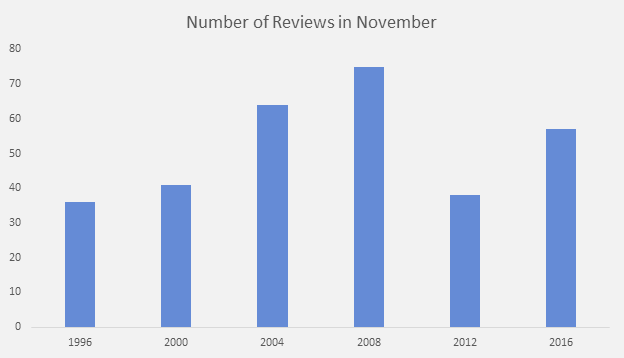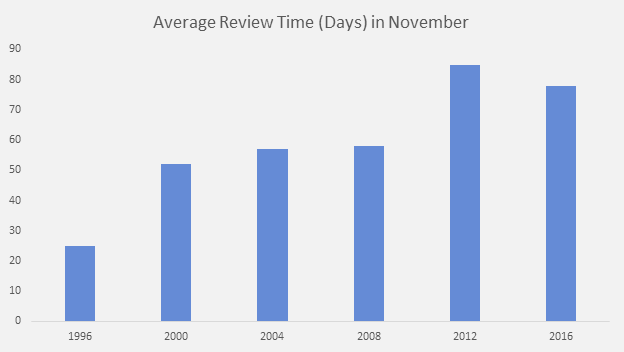Insight
December 6, 2016
Charting Midnight Regulation: November
With President-elect Trump set to take the oath of office on January 20, 2017, this is the official “midnight” period for regulation (defined as the period after Election Day, but before the next president takes office). There are now plenty of incentives for the Obama Administration to finalize regulations before President-elect Trump takes office. Although many of these midnight regulations might not survive, some will, and that is all the motivation necessary for regulators and the Office of Information and Regulatory Affairs (OIRA).
It appears there has been a midnight surge, although not one of historic proportions. Before November, the average monthly regulatory output in 2016 was 45.4. OIRA released 57 regulations in November, or an increase of about 26 percent, and more than any other month this year. In addition, OIRA concluded review of 14 “economically significant” measures (those with an economic impact of $100 million or more). That figure is more than any comparable midnight period, other than 2008, when regulators released 16 significant regulations. In addition to a busy November, the White House started off December strong, releasing 14 regulations on December 1 and 2.
Through the first 11 months of this year, regulators have approved 137 economically significant rulemakings; the next two closest years were 2008 and 2004, when regulators approved just 120 and 81 significant rules during the first 11 months. In other words, the White House has approved roughly 14 percent more significant regulatory action than any comparable period since 1996.
November 2016
The output in 2016 did not top the historic pace of 2008, when regulators approved 75 rules, or 4.1 rules a day. In 2016, OIRA released 57 rules, more than any other month in 2016, slightly topping May. Interestingly, it appears there was an incentive for the White House to release final rules in May because the Congressional Research Service estimates early June starts the period when the Congressional Review Act applies, allowing President-elect Trump and the next Congress to repeal rules from June to Inauguration Day. The chart below tracks overall regulatory activity during these midnight years.
For economically significant measures, November of 2016 was a close second to 2008. OIRA concluded review of 14 significant measures last month; this compares to 16 significant rules in 2008, 11 in 2000, and ten in 2012. Below are just some of the notable regulations released last month:
- Conservation Standards for Ceiling Fans
- Revision of Nutrition Facts for Meat and Poultry
- Passenger Equipment Safety Standards
- Renewable Fuel Standards for 2017
Despite the output of 14 significant measures, there are still 25 economically significant measures pending review (as of this writing), so agencies continue to add notable rulemakings at the White House. In November, OIRA received 36 additional measures that are still pending review, down from 63 in October of 2016 (including nine significant rules).
OIRA concluded review of several rules that had been under review for more than 120 days, which is the generally allowed timeframe for White House review under current executive orders. OIRA discharged eight rulemakings that had been under review for more than 120 days, including five measures that spent more than 200 days under review.
This November did not surpass all other similar periods during presidential election years for average review times, thanks in part to the politically manipulated backlog of rules from 2012. The average review time last month was 78 days, up from 59 days in October; this compares to a low mean of 25 days in November of 1996. However, November 2016 did have the longest median review time, of 71 days, compared to just 25 days in November of 2012.
For comparison, the chart below tracks the average review time since 1996 during midnight years.
Regarding “withdrawn” rulemakings, or measures that agencies and OIRA pull back from review, there were none in November. There were four withdrawn measures in 2008, and one each in 2012, 2004, and 2000. There is an obvious disincentive for agencies to withdraw rules this late during an administration and the White House has not aggressively pulled back regulations from review, at least compared to other similar periods.
The Cost
Thanks to AAF’s Reg Rodeo tool, the public can track regulatory costs and paperwork burdens over time, including data on major rules, Dodd-Frank, and the Affordable Care Act. In November 2016, regulators finalized $5.3 billion in costs, down from $38.6 billion in October. How does this compare to other similar periods? Although not a presidential election year, in November 2015, regulators published $15.1 billion in costs. In terms of paperwork, regulators published 12.2 million final hours this November, compared to November 2015, with 4.5 million hours.
Finally, there is the ultimate question of President Obama’s regulatory legacy. Through this point in his presidency (November of 2008), President George W. Bush had issued 476 major rules. By contrast, President Obama has issued 641, or 34 percent more than his predecessor. AAF will continue to publish monthly updates of similar periods in history.












